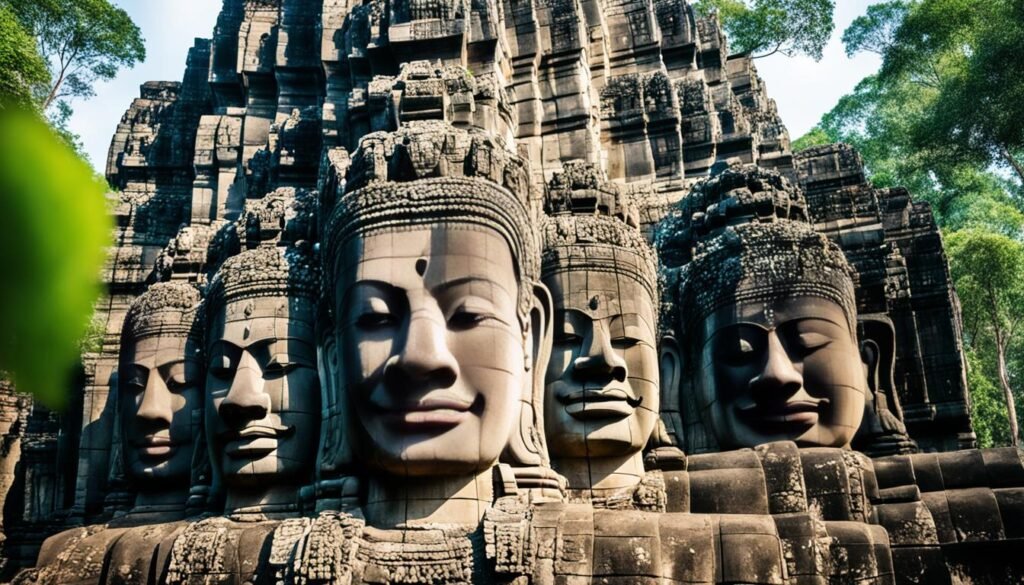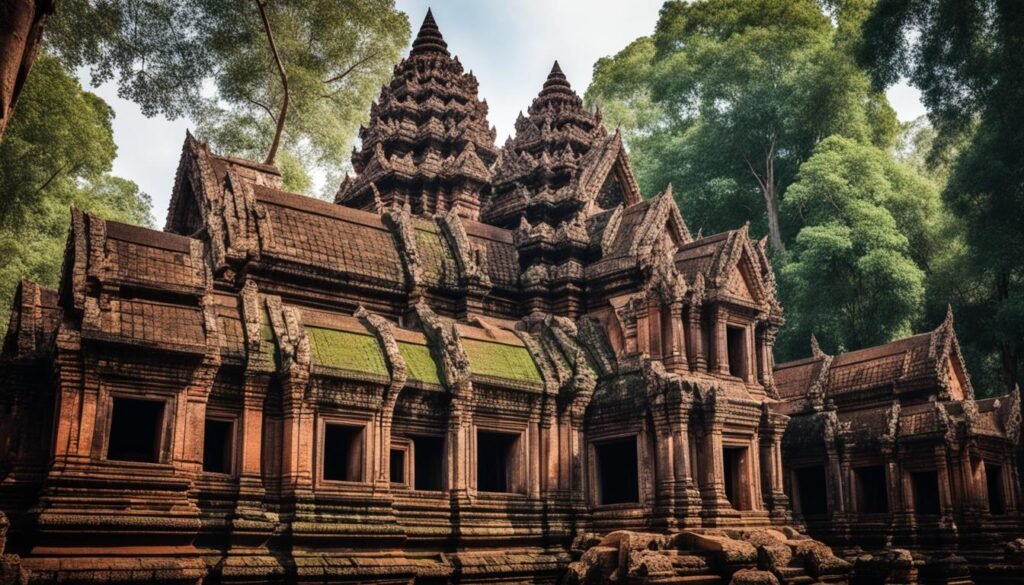Cambodia’s ancient temples are a window into the rich Khmer civilization and its wonders. Join us as we travel back in time to explore these amazing structures. They have amazed visitors for centuries.
Angkor Wat is the highlight of Cambodian history. It’s a UNESCO World Heritage site in a vast complex over 400 square kilometers. This shows the grand architecture of the Khmer Empire.
Recent studies show Angkor was a huge, low-density city. It was bigger than cities before the Industrial Revolution. This new info changes how we see cambodian history and its effect on cities worldwide.
Our journey takes us beyond Angkor Wat to hidden gems. Sites like Ta Prohm, with its jungle, and Bayon, with its mysterious faces, show us the past.
Key Takeaways
- Cambodia boasts over 1,000 ancient temples
- Angkor Wat is the world’s largest religious temple complex
- The Angkor Archaeological Park spans 400+ square kilometers
- LiDAR surveys revealed Angkor as a prehistoric mega-city
- Ta Prohm is known as the “Tomb Raider” temple
- Banteay Srei showcases intricate stone carvings from 967 AD
Introduction to Cambodia’s Rich Temple Heritage
Cambodia’s ancient architecture shows the grandeur of Southeast Asian culture. The Khmer Empire, from the 9th to the 15th century, left a lasting mark. Now, we can see these spiritual monuments that have amazed people for centuries.
The Khmer Empire’s Architectural Legacy
The Angkor Archaeological Park covers 400 square kilometers and shows the remnants of the Khmer capitals. It has over 100,000 people and 112 historic settlements. At its heart is Angkor Wat, built in the 12th century, a gem among Cambodia’s temples.
UNESCO World Heritage Sites in Cambodia
Cambodia has many UNESCO World Heritage Sites that show its rich culture. The Angkor complex, known for its Khmer art from the 9th to 14th centuries, was named a World Heritage site in 1992. After restoration, it was taken off the List of World Heritage in Danger in 2004. It’s now a top spot for culture lovers.
The Spiritual Significance of Cambodian Temples
These temples are more than just amazing buildings; they are spiritual places. They show the Khmer people’s devotion and skill. Originally for Hindu gods, then for Buddha, they reflect the area’s changing faiths.
| Feature | Description |
|---|---|
| Area | 400 square kilometers |
| Peak Population | 750,000 residents |
| Annual Visitors | Nearly 1 million |
| UNESCO Recognition | 1992 |
| Peak Tourist Season | December and January |
Exploring Cambodia’s temple heritage shows the balance between preserving and sharing these UNESCO sites. These monuments inspire and teach visitors from all over the world.
Angkor Wat: The Crown Jewel of Cambodian Temples
Angkor Wat is the top spot of Khmer civilization and Cambodian history. Built in the 12th century, it shows the greatness of ancient Cambodia. King Suryavarman II made it.
History and Architecture of Angkor Wat
Angkor Wat’s tale is one of high points and lows. It’s a massive complex, covering 400 square kilometers, that was the Khmer Empire’s center. The walls are filled with over a thousand apsaras and scenes from Indian stories.

Best Times to Visit and Photography Tips
For the best visit, try an 8-hour sunrise tour starting at 4:30 am. This lets you see Angkor Wat’s reflection in its moat. A 3-day pass, costing $62, gives you chances to see the sunrise and sunset at various spots.
| Pass Duration | Cost (USD) | Visitor Percentage |
|---|---|---|
| 1-day | $37 | 50-60% |
| 3-day | $62 | 30-40% |
| 7-day | $72 | 5-10% |
Exploring the Intricate Bas-Reliefs
The walls of Angkor Wat are filled with Khmer art. They show historical events and mythological stories. To really get into it, consider hiring a guide or using a detailed guidebook. This way, you won’t miss any of the amazing stories carved in stone.
Beyond Angkor Wat: Hidden Gems of Siem Reap
Siem Reap is more than just the gateway to Cambodia’s ancient architecture. It’s a place full of hidden treasures that show off the region’s rich history and spirituality.
Kbal Spean, also known as ‘the River of a Thousand Lingas,’ is a hidden gem. It’s a place where nature meets ancient art, making it a top spot for those looking for something different.
Preah Khan is a 12th-century temple complex just outside Siem Reap. It’s as grand as Angkor Wat and has intricate carvings and a large layout. It gives visitors a peek into the Khmer Empire’s architectural skills.
Koh Ker is another hidden treasure, once the capital of the Khmer Empire. Its pyramid-like structure shows the variety of spiritual sites in the area.
“Siem Reap’s hidden temples offer a journey through time, revealing the depth and complexity of Khmer civilization beyond Angkor Wat.”
Let’s compare some of these hidden gems:
| Temple | Distance from Siem Reap | Unique Feature |
|---|---|---|
| Banteay Srei | 45 minutes | Pink sandstone, intricate carvings |
| Beng Mealea | 1.5 hours | Jungle-covered ruins |
| Koh Ker | 2.5 hours | Pyramid-like structure |
| Preah Vihear | 3+ hours | Mountaintop location |
These hidden gems let you see Siem Reap’s ancient architecture without the crowds. They offer a closer look at Cambodia’s spiritual history.
Ta Prohm: Nature’s Embrace of Ancient Stone
Ta Prohm is a stunning gem in Cambodia’s ancient temples. It was built in the late 12th century. This ta prohm temple is a mix of human skill and nature’s beauty.
The “Tomb Raider” Temple’s Unique Appeal
Ta Prohm became famous as the “Tomb Raider” temple after the movie. Its design, with big tree roots, takes visitors back in time. The temple has five areas around a central spot, filled with detailed carvings of myths and everyday life.

Conservation Efforts and Challenges
Keeping Ta Prohm safe is hard. Workers try to keep its look while protecting it from damage. Big trees add beauty but also risk the temple’s safety. Some parts are closed for safety, showing the balance between saving and sharing the site.
Best Times for an Atmospheric Visit
Visit Ta Prohm in the late afternoon for the best experience. Fewer people are there, making it more personal. The soft light brings out the temple’s magical feel, loved by photographers and explorers.
| Feature | Description |
|---|---|
| Construction Period | Late 12th – Early 13th century |
| Builder | King Jayavarman VII |
| Architectural Style | Flat Khmer temple plan |
| Iconic Elements | Massive tree roots, stone ruins |
| Popular Culture | Featured in “Tomb Raider” film |
Bayon: The Enigmatic Faces of Angkor Thom

In the heart of Angkor Thom, Bayon temple stands as a masterpiece of Khmer civilization. Built in the late 12th century by King Jayavarman VII, it’s a Buddhist state temple. It shows the grandeur of ancient Cambodia with over 200 serene faces on its towers.
Originally, Bayon had 49 face-towers, but now it has 37 on the third level. These faces, with their broad smiles and open eyes, have sparked debate. Some think they represent the bodhisattva Avalokiteshvara, while others believe they depict Buddha Vajrasattva or Hindu deities.
The outer enclosure has intricate bas-reliefs showing life in 13th-century Cambodia. These scenes take us back in time, showing the vibrant Khmer culture. Inside, carvings blend Buddhist and Hindu imagery, showing the complex religious beliefs of the time.
- Bayon is the last state temple built in the Angkor Empire
- Each tower typically features four uniform faces
- Visitors spend about 1-2 hours exploring the temple
When visiting Bayon, remember to dress respectfully and stay on designated paths. Hiring a guide can make your visit better, giving you insights into the temple’s history and importance. As you explore this architectural wonder, you’ll feel the history and legacy of the Khmer civilization.
Discovering the Ancient Temples of Cambodia: Off the Beaten Path
Cambodia’s temple world is more than just Angkor Wat. Let’s explore hidden gems where ancient Khmer architecture shines without the crowds.
Banteay Srei: The Citadel of Women
Banteay Srei, the “Citadel of Women,” is a gem of Khmer art. It’s a small temple, about 25 kilometers from Angkor Wat, known for its pink sandstone carvings. The detail in its decorations is incredible, making it a top spot for art lovers.

Preah Vihear: A Temple with a View
Preah Vihear sits high on the Dangrek Mountains, offering stunning views of Cambodia. This UNESCO site, near the Thai border, showcases ancient Khmer architecture. Its remote spot, three hours from Siem Reap, means fewer visitors.
Koh Ker: The Pyramid of Cambodia
Koh Ker is an ancient city 120 kilometers from Siem Reap, filled with over 200 temples. Prasat Thom, a seven-tiered pyramid, stands out. This place gives a unique look into the Khmer Empire’s diverse architecture.
| Temple | Distance from Siem Reap | Unique Feature |
|---|---|---|
| Banteay Srei | 25 km | Intricate pink sandstone carvings |
| Preah Vihear | 240 km | Mountaintop location with panoramic views |
| Koh Ker | 120 km | Seven-tiered pyramid temple |
These hidden spots in Cambodia offer a peaceful break from the busy Angkor complex. By exploring beyond the usual paths, you’ll see the real beauty and variety of Cambodia’s ancient temples.
Preserving Cambodia’s Temple Heritage
Cambodia’s ancient temples are amazing examples of the country’s deep history. It’s vital to keep these treasures safe for the future. We look at how Cambodia keeps its heritage alive and the balance between tourism and conservation.
Restoration Projects and International Cooperation
Restoring temples like Angkor Wat requires careful work. Professor Hans Leisen leads the effort to save stone figures. He cleans off bat droppings, removes plants, and fixes cracks. International help is key to these efforts.
Balancing Tourism and Conservation
About 500,000 people visit Angkor Wat every year. It’s hard to keep a balance between tourism and protecting the site. The complex is huge, over 400 acres, and faces threats from the weather and people. We need sustainable tourism to keep this UNESCO site safe for visitors.
Local Community Involvement in Preservation
The Khmer people are learning how to restore their temples. This helps with long-term care of their heritage. Training locals is key to keeping Cambodia’s temples safe for the future.
| Aspect | Details |
|---|---|
| Temple Size | Over 400 acres |
| Annual Visitors | Approximately 500,000 |
| UNESCO Status | World Heritage Site since 1992 |
| Local Population | Siem Reap: Over 200,000 |
| Key Conservation Challenges | Climate impact, tourism pressure |
Planning Your Visit to Cambodia’s Temples
Planning a trip to Cambodia’s temples is important. We have gathered key cambodia travel tips for you. Let’s look at the basics: getting there and where to stay.
Siem Reap International Airport is the main entry point to the Angkor region. Upon arrival, you’ll find many siem reap accommodations for all budgets. Choices range from cozy hostels to luxurious resorts.
There are different options for angkor wat tickets. You can get a one-day ($20), three-day ($40), or seven-day ($60) pass. These passes give you access to the whole Angkor Archaeological Park. This includes famous spots like Angkor Wat and hidden treasures like Banteay Srei.
For getting around, think about hiring a tuk-tuk or renting a bicycle. A knowledgeable guide can add a lot to your experience, giving you deep insights into the site’s history and culture.
“Visiting at sunrise offers breathtaking views, while midday explorations often mean fewer crowds.”
Here’s a quick summary of what you should know:
| Item | Details |
|---|---|
| Best time to visit | November to March (dry season) |
| Temple opening hours | 5:00 AM – 6:00 PM |
| Popular temples | Angkor Wat, Bayon, Ta Prohm |
| Transportation options | Tuk-tuk, bicycle, guided tour |
Remember, temples like Ta Prohm are being taken over by nature, offering special photo chances. With these cambodia travel tips, you’re set for an unforgettable journey through Cambodia’s rich temple heritage.
Conclusion: The Timeless Allure of Cambodia’s Ancient Temples
Exploring Cambodia’s ancient temples takes us back in time. It shows us the greatness of a long-lost civilization. The Khmer Empire, from the 9th to the 15th century, left behind amazing sites that draw in millions every year. Angkor Wat, a key part of Cambodian history, covers 402 acres and welcomes over 2.5 million visitors yearly.
Our journey through Cambodia’s temples shows us incredible art and architecture. We see mysterious faces at Bayon and detailed carvings at Angkor Wat. These places tell us about the beliefs, customs, and ways of life of people long ago. Angkor Wat, once a key city, shows the skill of its creators.
Thinking about these ancient temples reminds us of the work to keep them safe. Balancing conservation with tourism is hard but important. It lets future generations see these wonders. Cambodia’s temples are not just a look back at the past. They also shape the present and future, captivating people worldwide.
FAQ
What are the most famous ancient temples in Cambodia?
A: Angkor Wat is the largest religious monument in the world. Ta Prohm is known for its tree-entwined ruins. Bayon is famous for its smiling faces on the temple walls.
Why are the Cambodian temples so significant?
The temples in Cambodia show the legacy of the Khmer Empire. They reflect the spiritual and human achievements of an ancient civilization. The temples have intricate carvings and structures dedicated to Hindu gods and Buddha.
What is the best time to visit Angkor Wat?
Visit Angkor Wat at sunrise for beautiful views. Or go in the mid-day to avoid the crowds. A guide can make your visit better by explaining the history and meaning behind the carvings.
What are some lesser-known but remarkable Cambodian temples?
A: Banteay Srei is known as the “Citadel of Women” for its pink sandstone carvings. Preah Vihear is a UNESCO site with stunning views from a high plateau. Koh Ker is a remote complex featuring a seven-tiered pyramid.
How can visitors contribute to the preservation of Cambodia’s temple heritage?
Visitors can help by supporting sustainable tourism and respecting the temples. Joining local conservation efforts is also a good idea. International groups like UNESCO are key to preserving these sites.
What are some practical tips for visiting the Cambodian temples?
Buy an Angkor Pass for your visit. Dress modestly. Use tuk-tuks, bicycles, or guided tours to get around. Remember to be mindful of the cultural sites and follow any rules.


